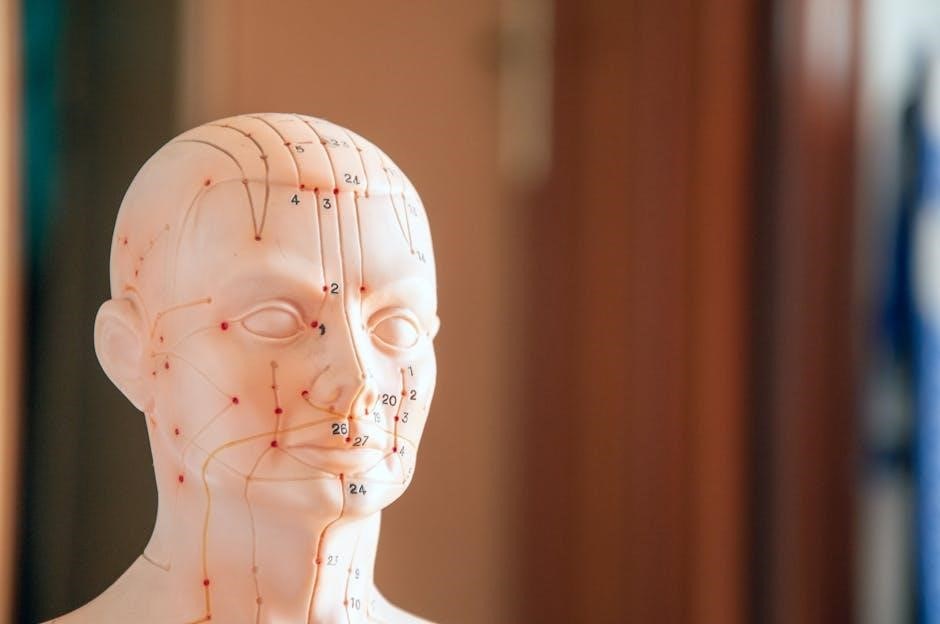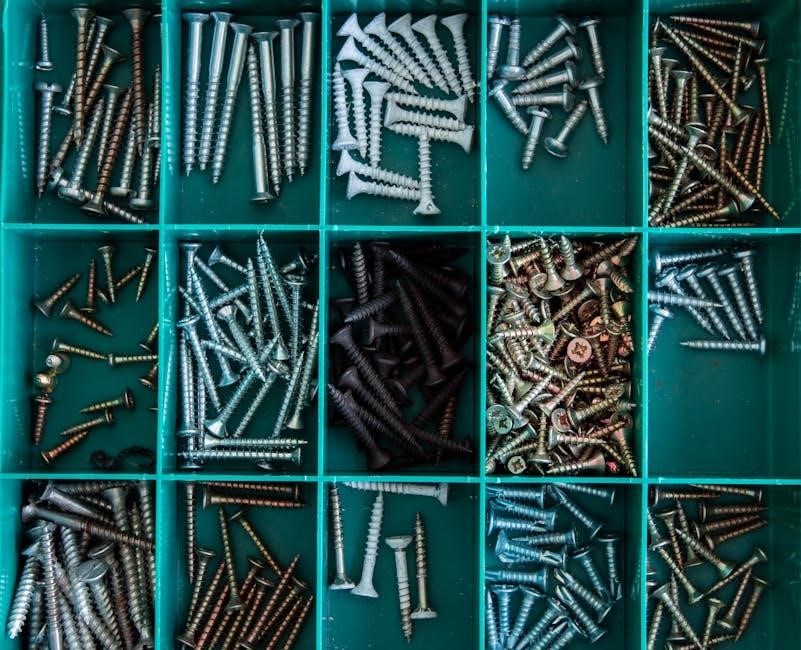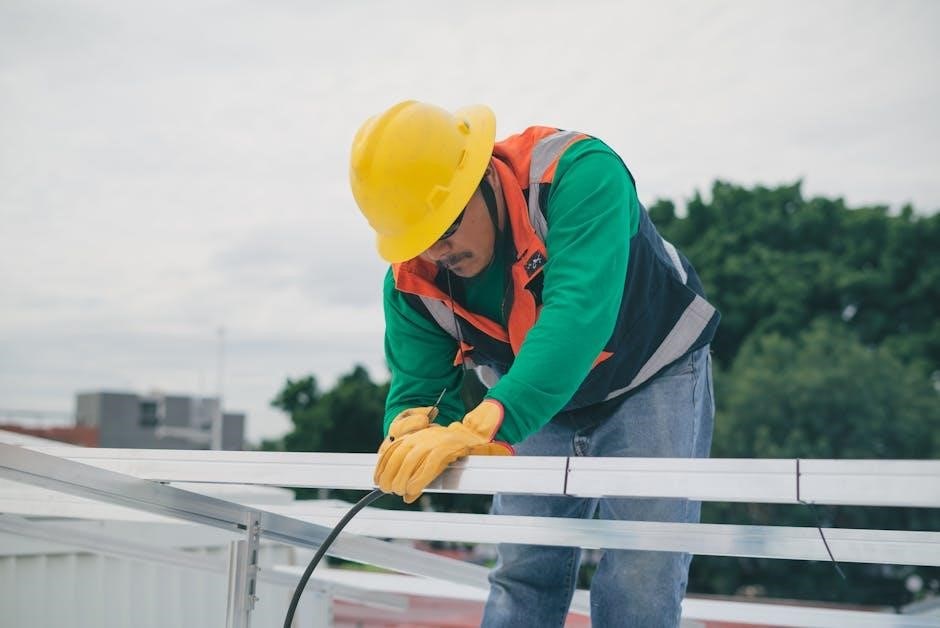Welcome! This manual simplifies the installation of your Honeywell TH5220D1003 thermostat. It provides step-by-step instructions for easy setup. Follow these guidelines for proper wiring and configuration. Ensure a comfortable home environment by correctly installing your new thermostat.
Product Overview
The Honeywell TH5220D1003 is a non-programmable digital thermostat designed for ease of use and reliable temperature control in residential and light commercial settings. As part of the Honeywell FocusPRO series‚ it offers a balance between simplicity and essential functionality. This thermostat is compatible with a wide range of heating and cooling systems‚ including single-stage and multi-stage configurations‚ as well as heat pump systems‚ enhancing its versatility for various installation environments.
Its clear‚ backlit display ensures easy readability‚ even in dimly lit areas‚ while the intuitive interface allows users to quickly adjust temperature settings. The TH5220D1003 focuses on providing accurate temperature management‚ maintaining a consistent and comfortable indoor climate;
Installation is straightforward‚ making it suitable for both DIY enthusiasts and professional installers. The thermostat’s design prioritizes user-friendliness‚ eliminating the complexities of programmable models. It is ideal for users who prefer manual temperature adjustments. With its dependable performance and simplified operation‚ the Honeywell TH5220D1003 offers a cost-effective solution for basic thermostat needs‚ ensuring efficient and reliable climate control. Remember to disconnect power before beginning any wiring.
Pre-Installation Checklist
Before you begin installing your Honeywell TH5220D1003 thermostat‚ it’s essential to complete a pre-installation checklist to ensure a smooth and safe process. First‚ verify that the thermostat is compatible with your heating and cooling system by checking the system type and voltage requirements. Gather all necessary tools‚ including a screwdriver (both Phillips and flathead)‚ wire stripper‚ level‚ drill‚ and pencil. Ensure you have enough thermostat wire (18-22 gauge) to connect the thermostat to your system.

Turn off the power to your heating and cooling system at the breaker box to prevent electrical shock. Remove the old thermostat from the wall and carefully disconnect the wires‚ labeling each wire with its corresponding terminal designation. Take a photo of the existing wiring configuration for reference during the new installation. Inspect the wall for any damage or holes and repair as needed to ensure a secure mounting surface.
Finally‚ review the Honeywell TH5220D1003 installation manual to familiarize yourself with the wiring diagrams and setup procedures. By completing this pre-installation checklist‚ you’ll be well-prepared to install your new thermostat efficiently and safely. Confirm that you have all components before proceeding.
Disconnect Power Supply

Before commencing any wiring or installation procedures for your Honeywell TH5220D1003 thermostat‚ disconnecting the power supply is paramount for your safety and the integrity of your equipment. Locate the circuit breaker that controls your heating and cooling system within your home’s electrical panel. Typically‚ this breaker will be labeled “Furnace‚” “HVAC‚” or something similar‚ but if unsure‚ consult your home’s electrical diagram or a qualified electrician.
Once you’ve identified the correct breaker‚ switch it to the “OFF” position. This action will cut off the electrical supply to your thermostat and the connected heating and cooling equipment. To ensure the power is completely disconnected‚ it’s advisable to test the wires at the old thermostat with a non-contact voltage tester. This step verifies that no electricity is flowing through the wires‚ mitigating the risk of electrical shock during the installation process.
Never assume the power is off without confirming it with a tester. If you’re uncomfortable working with electrical components‚ it’s best to seek assistance from a licensed electrician. Safety should always be your top priority when handling electrical systems. Disconnecting the power supply is a critical step.
Wiring Preparation: Taking a Picture of Old Wiring
Before disconnecting any wires from your existing thermostat‚ it is absolutely crucial to take a clear and detailed photograph of the current wiring configuration. This photo serves as an invaluable reference point during the installation of your new Honeywell TH5220D1003 thermostat‚ ensuring that you reconnect the wires correctly. Use a smartphone or digital camera to capture an image that clearly shows each wire and its corresponding terminal connection on the old thermostat.
Ensure the lighting is adequate and the photo is in focus‚ allowing you to easily identify the wire colors and terminal labels. It’s also a good idea to take multiple pictures from different angles to provide comprehensive documentation. Once you have captured the images‚ save them to your phone‚ computer‚ or cloud storage for safekeeping.
This visual record will be especially helpful if you encounter any confusion or uncertainty during the wiring process. By having a readily available reference‚ you can avoid potential wiring errors that could damage your thermostat or heating and cooling system. Taking a picture is a simple yet essential step.
Carefully label each wire if the colors are faded or difficult to discern. Consider using small pieces of masking tape and a pen. This will further enhance the clarity.
Wallplate Installation
The next crucial step in installing your Honeywell TH5220D1003 thermostat is the wallplate installation. Start by carefully separating the wallplate from the thermostat body. This is usually achieved by gently pulling the two pieces apart. Ensure you are using the correct wallplate that came specifically with your new thermostat model to guarantee compatibility and proper fit.
Next‚ position the wallplate against the wall at the desired location where your old thermostat was mounted. Use a level to ensure the wallplate is perfectly straight before marking the screw holes. Accurate leveling is essential for the aesthetic appearance and correct functioning of the thermostat. Once you are satisfied with the position‚ use a pencil to mark the locations for the mounting screws through the holes in the wallplate.
After marking the holes‚ carefully drill pilot holes at the marked spots. The size of the drill bit should be appropriate for the screws you will be using to secure the wallplate. If you are mounting the wallplate on drywall‚ consider using wall anchors to provide extra support and prevent the screws from stripping the drywall.
Finally‚ align the wallplate with the drilled holes and use the provided screws to attach it securely to the wall. Do not overtighten the screws‚ as this could damage the wallplate or the wall itself. Make sure the wallplate is firmly attached and does not wobble.
Wiring Instructions
Before commencing the wiring process for your Honeywell TH5220D1003 thermostat‚ it’s paramount to ensure the power supply to your heating and cooling system is completely disconnected. This crucial safety measure prevents any risk of electrical shock and safeguards your equipment from potential damage during the installation. Double-check the breaker to confirm power is off.

With the power safely off‚ carefully identify each wire from your existing thermostat and compare it to the wiring diagram provided in this manual. The diagram will illustrate the correct terminal connections on the TH5220D1003 for various system configurations‚ such as conventional heating/cooling or heat pump systems. Accurate identification is key to avoiding operational issues.
Using small pliers or a screwdriver‚ gently connect each wire to its corresponding terminal on the wallplate. Ensure each wire is securely fastened to its designated terminal to guarantee a stable electrical connection. Loose connections can lead to intermittent operation or even system failure. Refer to the terminal designations section for specific details on each terminal’s function.
If your system requires a jumper wire‚ ensure it is correctly placed between the appropriate terminals‚ as indicated in the wiring diagram. Jumper wires are often used to bridge terminals for specific system configurations. After wiring‚ carefully tuck any excess wire back into the wall opening to prevent interference with the thermostat unit when it’s mounted.
Terminal Designations
Understanding the terminal designations on your Honeywell TH5220D1003 thermostat is crucial for correct wiring and optimal system performance. Each terminal serves a specific function within your heating and cooling system‚ and connecting wires to the wrong terminals can lead to malfunctions or even damage to your equipment. This section provides a comprehensive overview of each terminal’s purpose.
The “R” terminal typically denotes the power supply from the transformer‚ usually 24VAC. In single-transformer systems‚ this wire often connects to both the “R” and “Rc” terminals using a jumper wire. For systems with separate heating and cooling transformers‚ the “R” terminal is for the heating transformer‚ while the “Rc” terminal is for the cooling transformer. Remove the jumper in such cases.
The “Y” terminal controls the compressor in your cooling system. When the thermostat calls for cooling‚ it sends a signal to the “Y” terminal‚ activating the compressor and initiating the cooling cycle. The “G” terminal controls the fan. In most systems‚ connecting a wire to this terminal will turn on the fan independently of heating or cooling.
The “W” terminal activates the heating system. When the thermostat calls for heat‚ it sends a signal to the “W” terminal‚ starting the heating process. The “C” terminal‚ often blue‚ provides a common wire‚ ensuring consistent power to the thermostat for proper operation‚ particularly for advanced features. Lastly‚ the “L” terminal is powered continuously in Emergency Heat mode.
Wiring Diagrams
This section provides a series of wiring diagrams to assist you in correctly connecting your Honeywell TH5220D1003 thermostat to various heating and cooling systems. These diagrams are essential for ensuring proper functionality and preventing damage to your equipment. Each diagram corresponds to a specific system configuration.
The first diagram illustrates a typical single-stage heating and single-stage cooling system. In this configuration‚ the “R” terminal connects to the 24VAC power supply‚ the “Y” terminal controls the compressor‚ the “G” terminal operates the fan‚ and the “W” terminal activates the heating system. A common wire (“C” terminal) is also shown for consistent power.
Another diagram showcases a heat pump system without auxiliary heat. This setup typically involves connections to the “R‚” “Y‚” “G‚” and “O/B” terminals. The “O/B” terminal controls the reversing valve‚ determining whether the heat pump provides heating or cooling.
For systems with two transformers‚ separate diagrams illustrate how to connect the “R” and “Rc” terminals from the heating and cooling transformers‚ respectively. It is crucial to remove any factory-installed jumper between these terminals in this configuration.
Ensure you select the wiring diagram that accurately reflects your specific system type. Carefully follow the connections depicted in the diagram to avoid miswiring‚ which could lead to operational issues or equipment damage. If unsure‚ consult a qualified HVAC technician.

Power Options
The Honeywell TH5220D1003 thermostat offers flexible power options to accommodate different installation scenarios. Understanding these options ensures a smooth and reliable operation. Primarily‚ the thermostat is designed to be powered by a 24VAC system‚ which is the standard for most modern HVAC systems. This requires a common wire (“C” terminal) connection for stable power.
However‚ in situations where a common wire is not readily available‚ the thermostat can often operate using a two-wire system‚ drawing power from the heating or cooling equipment. This configuration may require careful consideration of the system’s power demands to ensure sufficient power for the thermostat’s operation.
For systems with two transformers‚ one for heating and one for cooling‚ it’s essential to manage the power connections correctly. Typically‚ this involves connecting the “R” terminal to the heating transformer and the “Rc” terminal to the cooling transformer‚ while removing any factory-installed jumper between these terminals. This separation prevents interference and ensures proper power distribution.
It’s crucial to verify the voltage and power requirements of your specific HVAC system before making any power connections. Incorrect wiring can lead to thermostat malfunction or damage to the HVAC equipment. Consulting the system’s documentation or a qualified technician is recommended for complex installations or if you’re unsure about the power requirements.
Mounting the Thermostat
Once the wiring is complete‚ the next step is to securely mount the Honeywell TH5220D1003 thermostat to the wall. Begin by carefully aligning the thermostat body with the installed wallplate. Ensure that all wires are neatly tucked into the wall opening to prevent any interference with the thermostat’s seating.
Gently push the thermostat onto the wallplate until it snaps firmly into place. You should hear a distinct click‚ indicating that the thermostat is securely attached. Avoid applying excessive force‚ as this could damage the thermostat or the wallplate.
After mounting‚ visually inspect the thermostat to ensure it’s level and flush against the wall. A level installation enhances the thermostat’s appearance and ensures accurate temperature readings. If necessary‚ make minor adjustments to the wallplate’s position before tightening the screws.
Finally‚ insert the battery holder if batteries are used‚ and close the thermostat cover if applicable. The thermostat should now be ready for the installer setup‚ where you’ll configure it to match your specific heating and cooling system. Proper mounting is crucial for the thermostat’s stability and performance‚ so take your time and ensure it’s done correctly.
Installer Setup: Configuring the Thermostat
After successfully mounting your Honeywell TH5220D1003‚ the next crucial step involves configuring the thermostat to match your specific heating and cooling system. This “Installer Setup” ensures optimal performance and accurate temperature control. Begin by accessing the setup menu‚ typically through a combination of button presses as detailed in the manual.
Within the setup menu‚ you’ll find various parameters to adjust. The most important setting is the system type‚ which defines whether you have a conventional furnace‚ heat pump‚ or other heating/cooling configuration. Select the appropriate option to ensure the thermostat operates correctly with your system.
Next‚ configure the number of heating and cooling stages your system utilizes. This setting allows the thermostat to manage multi-stage systems efficiently. Other configurable options might include temperature display (Fahrenheit or Celsius)‚ temperature swing (cycle rate)‚ and backlight settings. Consult the manual for detailed explanations of each parameter.
Carefully review each setting and adjust it according to your system’s specifications. Incorrect settings can lead to inefficient operation or even damage to your equipment. Once you’ve completed the configuration‚ save the changes and exit the setup menu; Your Honeywell TH5220D1003 thermostat is now ready to provide precise and reliable temperature control.
Troubleshooting
Even with careful installation‚ occasional issues may arise with your Honeywell TH5220D1003 thermostat. This troubleshooting section provides guidance on resolving common problems. If your thermostat isn’t displaying any information‚ first check the batteries‚ ensuring they are correctly installed and have sufficient power. A blank display often indicates a power issue.
If the thermostat displays an incorrect temperature‚ verify the sensor is clean and unobstructed. Also‚ ensure the thermostat is not exposed to direct sunlight or drafts‚ which can affect temperature readings. If your heating or cooling system isn’t responding to thermostat changes‚ double-check the wiring connections.
Loose or incorrect wiring can prevent proper operation. Refer to the wiring diagrams in this manual to confirm accurate connections. If your system cycles on and off too frequently‚ adjust the temperature swing setting in the installer setup menu. A wider swing can reduce cycling frequency.
For more complex issues‚ consult the Honeywell website or contact a qualified HVAC technician. They can diagnose and resolve problems beyond the scope of basic troubleshooting. Remember to have your thermostat model number handy when seeking support. Always disconnect power before inspecting wiring.
Recycling and Proper Disposal
When your Honeywell TH5220D1003 thermostat reaches the end of its useful life‚ it’s crucial to dispose of it responsibly. This ensures environmental protection and compliance with local regulations. The thermostat contains electronic components and‚ in some cases‚ batteries that should not be discarded with regular household waste.
Before disposing of the thermostat‚ remove the batteries. Check your local regulations for battery recycling programs. Many communities offer designated drop-off locations for used batteries. For the thermostat itself‚ consider recycling options. Electronic waste recycling programs are available in many areas.
These programs ensure that electronic devices are dismantled and processed in an environmentally sound manner‚ recovering valuable materials and preventing harmful substances from contaminating the environment. Contact your local waste management authority or search online for e-waste recycling facilities in your area. Some retailers may also offer take-back programs for old thermostats.
By participating in recycling programs‚ you can contribute to a circular economy and minimize the environmental impact of electronic waste. Proper disposal not only protects the environment but also helps conserve resources for future generations. Always prioritize responsible recycling practices.
